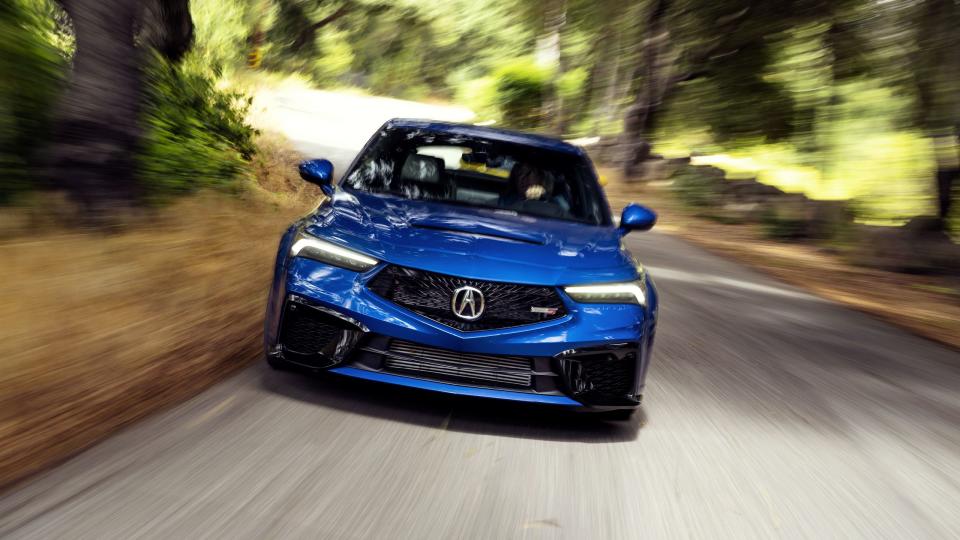Would the Real Acura Integra Please Step Forward?


The most moronic thing I’ve ever done in a car was in an Acura Integra. My best friend had a circa-1988 first-gen, and we had just gotten our driver’s licenses. Acura had launched in the U.S. two years earlier, and the Integra was one of two original models. We loaded the cargo hold with cases of Miller and road-tripped on icy highways through New Hampshire, every gauge pinned. At one point, he locked in with a guy in a gold Saab, who passed us at over 100 mph on a highway shoulder. Kids die every day doing this shit. One reason we survived was because that Integra was so sure-footed.
This story originally appeared in Volume 18 of Road & Track.
Jump to June 2023, and I’m in an Integra for the first time since. My assignment: compare the all-new, tech-forward, 320-hp turbocharged Integra Type S and the legendary VTEC-junkie, 195-hp 2001 Type R. That’s the ITR, and, to those with discernment and experience, the best-handling front-driver ever mass-produced. Honda/Acura at its current best versus peak Honda. No winner or loser, but an illumination of how driving expectations and standards have changed.

The day began in the old Type R, on roads curling through hills outside Ojai, California. The car had just rolled off the floor of Honda’s Southern California museum, the American Honda Collection Hall. Acura sold less than half as many ITRs in the U.S. as it did first-gen NSXs, and this one had barely over 6000 miles on it. It’s pretty much worth more than my life.
Not that I treated it that way. The first thing this car communicates to its driver is desire. It wants to run hard. By today’s standards, it is tiny. The all-aluminum B18C5 naturally aspirated 1.8-liter four-cylinder puts out only 195 hp. But the packaging is so diminutive, the feel so purely mechanical, that the experience of power is instant and visceral. Something amazing happens driving a Type R on winding, hilly roads. You power into a fast-sweeping bend, and the torque just keeps coming. The engine hits 6000 rpm and the variable valve timing shifts the camshaft, making the engine change its pitch as output increases. The VTEC is a good kick in the pants, and the revs rise to the 8400 redline.

The Type R has no screens, drive modes, traction control, computer interventions, or auto transmission, and little noise dampening. Five-bolt alloy 15-inch wheels and 195-width tires seem cute by today’s standards, but it is all perfectly optimized to make the engine in the driver’s ribcage hum. Acura produced the Type R with a 15-mm-lower ride height than the standard Integra, and that center of gravity translates to grip in speedy cornering. The view through the windscreen is all rapid motion; glance in the rearview, and you see that giant yellow wing. You feel like you’re in a race car, and for good reason: SCCA Hall of Famer Peter Cunningham raced almost-stock Type Rs back in the day, claiming plenty of checkered flags.
The cockpit feels like a time capsule, with analog gauges, a digital clock reminiscent of an Eighties Atari game, and a CD player. Care for a Marlboro? There’s an ashtray on the console and a lighter bearing a smoking-cigarette logo.

While the Phoenix yellow paint is anything but inconspicuous, the ITR’s exterior doesn’t scream performance. But numerous times during the day, Honda fans stopped to ogle the car. At one point, a pair of enthusiasts parked their Acuras on the side of the road to record with their phones as I powered the Type R back and forth on a twisty strip of pavement, our photographer snapping away from a nearby hill. Their joy was infectious but paled next to the pleasure I felt sitting in the Type R’s driver’s seat.
When you look at the new Integra Type S, you’re struck first by its size. Everything is bigger and heavier. In place of the naturally aspirated 1.8-liter four-cylinder is the same K20C1 turbocharged 2.0-liter four used in the Civic Type R. In place of the five-speed is a manual six. (There's no automatic for the Type S.) In place of the 15s are 19s inside 265-mm-wide rubber. It has four doors rather than two, actual room for four people, and more girth all around. The modern Brembos are much bigger. The dashboard features so many more knobs and switches. Even the steering wheel feels twice the size.

Subtle design elements run through both cars. The unchanged Integra logo is embossed in the same spot, on the passenger’s side of the rear fender, and the gear map is imprinted in red on top of the shift knob in both. That aside, you could look at these cars and not know they share much of anything. The new Integra features polished exhaust pipes stretching out of a Type S-exclusive rear diffuser reminiscent of a C7 Corvette’s, only with three tubes instead of four.
The Type S is not just a vehicle but a computing device. The gauges are all digital. There are three drive modes (plus a customizable option), with Sport+ for peak performance. There is no ashtray or CD player, but there is a large touchscreen, satellite radio, and device connection.

Hit the road, and you’re struck by how much more power you have at your disposal. This motor kicks out 320 hp (compared with 195) and 310 lb-ft of torque (compared with 130). The torque comes on much lower and seems significantly less mechanical. The throttle response feels less instant. Ample sound dampening lessens the volume next to the Type R. But the pleasure of motoring—the way the engine communicates desire—is there. Powering into quick corners, feeling the g-forces jam my backside into the seat, I feel the lineage that connects the old Integra with the new. Any engineer can build neato vehicular technology, but the best create joy.
In an ideal world, you would want an old Type R for weekend motoring and a more comfortable, quieter, roomier, modern Type S for commutes and road trips. Just don’t fill the trunk with beer and go street racing on icy highways.

A car-lover’s community for ultimate access & unrivaled experiences.JOIN NOW Hearst Owned
You Might Also Like

 Yahoo Autos
Yahoo Autos 